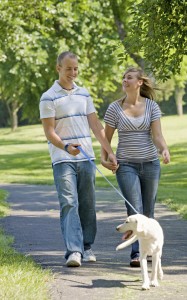 In the U.S. , excess calories and minimal movement are creating a health crisis for both people and dogs. Not only people, but our dogs and cats too are suffering from being overweight or obese. Some research suggests 40% of our dogs are overweight and they suffer from the same complications that overweight people do such as joint pain and heart disease.
In the U.S. , excess calories and minimal movement are creating a health crisis for both people and dogs. Not only people, but our dogs and cats too are suffering from being overweight or obese. Some research suggests 40% of our dogs are overweight and they suffer from the same complications that overweight people do such as joint pain and heart disease.
It is often a daunting task just to get started with an exercise program. Many programs recommend getting started with a partner. Enter….your dog! Walking or running is an excellent way for all species to get back into shape. Among other benefits, a recent study suggested that there is a release of hormones in people and dogs – the “runner’s high” – that comes from intense activity. Our dogs are almost always ready for a brisk walk, so they provide us the perfect motivation to get up and out.
Too much all at once equals sore muscles and the need to rest once again so easing into a walking-running program is the way to start and stick with it. For example, try starting with just 20 minutes, alternating 60 seconds of jogging with 90 seconds of walking. Working out just 3 days a week, these intervals should continue to increase progressively until it is all running for 30 minutes (it doesn’t have to be at marathon speed – even fast walking alternated with normal pace will get your heart rate up). (Check out Pooch to 5k at www.poochto5k.com to download free training programs that you can do with your dog).
When walking, hiking, biking, or running with your dog, be sure to use commonsense as our dogs can’t tell us when they are finding it too tough. You have to adapt your regime to your dog’s ability and a slow, progressive buildup, moderation and adequate recovery are all essential. Know when your dog has had too much. For example, he starts lagging, a change in the jingling sound of the collar tag (could indicate a change in the dog’s gait indicating pain or injury), panting harder than usual, or if your dog is still sluggish the next day he may be experiencing aches and pains – a dog should be recovered from exercise by the next day.
It is also important to exercise commonsense to ensure you do not trip over your dog, especially if running together. Before embarking on a training program that includes jogging or running, make sure your dog knows to walk on a loose lead and to stay at your side (or ahead on a 6′ lead). Spare yourself the skinned knees and fractured bones by teaching your dog proper leash manners.
Many people have found that once they get into a routine with their dog, whether it’s walking or running, their dog gets hooked and this in turn motivates the owners. The dog turns into a demanding coach. And to be worthy of your partner and coach, you will continue to get up and get going!
